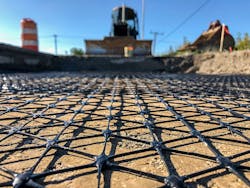This week we discuss how the “new normal” is directly impacting projects. What hurdles are being encountered on jobsites and have any new design approaches emerged as a result of COVID-19? We asked several people from top engineering and construction firms, suppliers and state agencies to share their perspectives.
Have you seen any impacts to supply chain when dealing with suppliers or subcontractors?
-
Nick DiBartolo – (Vice President - Rogers Group, Inc.) We have the same problem as everyone related to the industrial hygiene sector, but for the most part, our chain remains unbroken. We have been served a few notices of the potential for delays due to COVID-19 from some subs, but for the most part this appears to be a cautionary move to protect claimant rights in line with the construction contract.
-
James Bailey (Senior Vice President – Skanska USA Civil) We have seen very limited impact to the supply chain on our projects. We have seen some impacts to specialized items coming from Italy and other impacted areas.
Do you anticipate an increased usage of delivery methods such as design/build and/or PPP to construct projects associated with a potential infrastructure stimulus package?
-
Chris Carry (Vice President of Sitework - Mosser Construction, Inc.) We have seen a lot of interest starting to occur in design build based on the thought process of being able to control costs early in the construction cycle process.
-
Steve Eckhart – (Central Area Director – Tensar) We are seeing an increased level of interest in value-engineering proposals. Due to the economic impacts of COVID-19, most private and public customers are experiencing budget shortfalls due to cuts in capital expenditures and to a loss of tax revenue. This current reality has increased the receptivity to the unique solutions we have offered that provide a higher level of performance at lower costs. Our history of success with subgrade stabilization and pavement optimization coupled with the economic benefit our solutions offer is gaining traction in the private and public markets.
-
Randell Iwasaki – (Executive Director - Contra Costa Transportation Authority) As a local agency, our options are limited as we don’t have the authority to use Design/Build, and the State of California has allowed the P3 authority to lapse. However, the Contra Costa Transportation Authority Board (CCTA) just approved the use of Construction Manager/General Contractor (CM/GC) delivery method for a cable-stayed bridge within the City of San Ramon. We worked with our state Assembly Member Bauer-Kahan to write the legislation that would allow local agencies like ours to use CM/GC for projects not on the State Highway System. Currently, using an alternative delivery method like CM/GC on the State Highway System in California requires you to use the California Department of Transportation for inspection.
-
Jeff Lackey (Vice President – TranSystems, Inc.) It's tough to say but I do expect some increases in design/build and PPP. History has shown us with stimulus packages that alternative delivery has been a part of that process. I would anticipate that would be the case with any new stimulus that would be passed.
-
Michael Mangione (Senior Vice President – WSP USA) States and transportation/toll agencies are realizing negative revenue impacts and the length of recovery will be dictated by the amount of revenue lost. If a federal stimulus bill provides increased funding, some states may take advantage of design-build to deliver projects. Others may also trend toward other alternate delivery methods such as CMGC or progressive design-build to speed delivery. P3s may also be attractive as funding is tight and the market historically values infrastructure projects as strong investments. States that do not currently allow P3s will be slow to initiate, if at all.
Are the impacts from the COVID-19 pandemic resulting in any change in the frequency of requested changes to projects after construction has started? The majority of panelist indicated no or only minor changes to date.
-
Jeff Lackey (Vice President – TranSystems, Inc.) We have not seen this on the projects that we are providing CEI services for.
-
Randell Iwasaki – (Executive Director - Contra Costa Transportation Authority) The only change we have seen is more onerous requirements for reporting, modifying the safety plans, and creating a COVID-19 safety compliance officer and Superintendent. Just prior to the start of the pandemic, we implemented a contract change order to accelerate a project by 365 calendar days.
-
Bill Lawrence (Materials Manager – Utah Department of Transportation) From my experience and perspective as the Materials Manager for the Utah DOT, I would answer this question as no.
Are the impacts from the CVD-19 pandemic changing interest/approval of value-engineering proposals and if so, why?
-
Nick DiBartolo – (Vice President - Rogers Group, Inc.) While we have yet to see this directly, I would imagine that any reasonable proposal would get serious consideration. Depending on your state/locale, more than half of an entity's revenue could be derived from sales tax. When the economy is shut down, there's obviously a tremendous reduction in operating income. Listening to and fairly evaluating VE proposals is just sound fiscal policy.
-
Chris Carry (Vice President of Sitework - Mosser Construction, Inc.) We haven't necessarily seen this yet, however, I would assume as funding impacts are felt VE items will become far more relevant and also influential.
-
James Bailey (Senior Vice President – Skanska USA Civil) No, we are seeing an increased interest in VE proposals to save money and to accelerate projects.
We thank our panelist for sharing their valuable perspectives with us. Join us next week for Part 3 when we will discuss the long-term implications of the “new normal” on construction practices.



